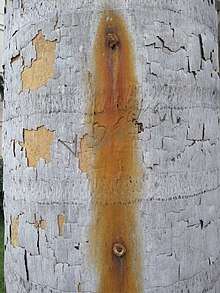Tree spiking

Tree spiking involves hammering a metal rod, nail, or other material into a tree trunk, either inserting it at the base of the trunk where a logger might be expected to cut into the tree, or higher up where it would affect the sawmill later processing the wood. It is used to prevent logging by risking damage to saws, in the forest or at the mill, if the tree is cut. The spike reduces the commercial value of the wood by causing discoloration, thereby reducing the economic viability of logging in the long term, without threatening the life of the tree.
It is believed that tree spiking originated in timber logging labor disputes in the Pacific Northwest of the United States in the late 19th century. It came to prominence as a contentious tactic within unconventional environmentalist circles during the 1980s, after it was advocated by Earth First! co-founder Dave Foreman in his book Ecodefense. In the book, he discusses how to do it and how to avoid risks to the activist and the logger.
In 1987, California mill worker George Alexander was seriously injured when the bandsaw he was operating hit an 11-inch spike embedded in a 12-inch trunk with a worn-out blade he had earlier requested to be replaced. This event led the leader of Earth First! to denounce tree spiking.[1]
Other activists were led to either reject this form of sabotage entirely, or take some precautions, such as putting warning signs in the area where the trees are being spiked. Tree spiking is labeled as eco-terrorism by logging advocates who claim it is potentially dangerous to loggers or mill-workers,[2] although only this one injury resulting from tree spiking has been reported.[1]
New Zealand
Beech trees that were being logged in 1998 in the Tuatapere area were spiked. Police were unable to trace those who were responsible.[3]
Pat O'Dea, while he was the mayor for the Buller District, suggested in 2000 that Native Forest Action (NFA) had spiked trees during a direct action campaign against native forest logging on the West Coast.[4] This was denied by NFA spokesperson Dean Bagient-Mercer.[5] In 1998 Kevin Smith from Forest and Bird had said that tree spiking was proposed by some individuals involved in the NFA campaign.[3]
United States
Following the 1987 injury of California mill worker George Alexander, tree spiking was declared a federal felony in the United States in 1988. (18 U.S. Code 1864).
In 1990, Earth First! leader Judi Bari led activists in Northern California and Southern Oregon to renounce tree-spiking as a tactic on the eve of Redwood Summer, a 1990 campaign of nonviolent protests against logging of the redwood forest.[6]
See also
References
- 1 2 Rowell, Andrew (1996). Green Backlash. Routledge. p. 153. ISBN 9780415128285.
- ↑ Ecoterrorism: The Dangerous Fringe of the Environmental Movement
- 1 2 Nixon, Tina (1998-01-06). "Spikes put workers' lives at risk". The Southland Times.
|access-date=requires|url=(help) - ↑ Madgwick, Paul (2000-04-14). "Public backlash around NZ feared". The Press.
|access-date=requires|url=(help) - ↑ Bagient-Mercer, Dean (2000-04-27). "West Coast forests". Letter to the Editor. The Press.
|access-date=requires|url=(help) - ↑ "Tree-spiking renunciation & Mississippi summer in the California redwoods Archived 2008-05-09 at the Wayback Machine."
External links
- The Secret History of Tree Spiking by Judi Bari
- Earth First! Memo: Tree-spiking renunciation NOTE: This page is no longer available; to learn about the current Earth First! tree protection activities, go to their Tree Sits page.